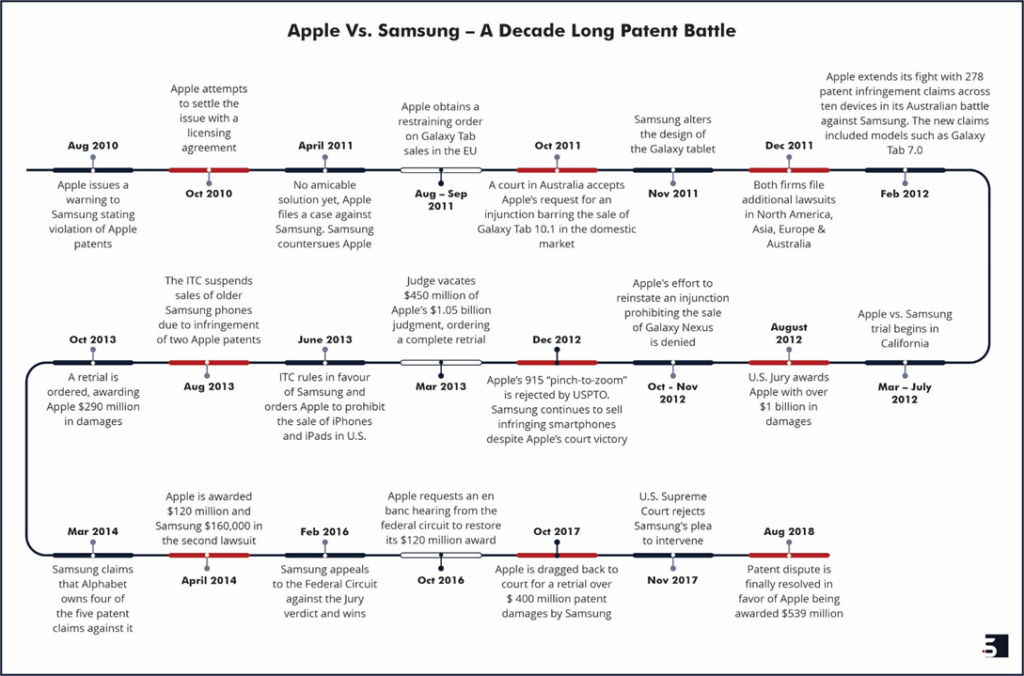Design Patents: Your Secret Weapon to Protect Innovations in a World Dominated by Visuals
Smartphones have become indispensable, ushering in an era of technological advancement and fierce competition. In the heart of this battleground lies the Great Patent War, epitomized by clashes between giants like Apple and Samsung trial in 2012. These battles, fought in both courts and marketplaces, underscore the importance of a design patent in protecting innovation and preserving brand identity.
In this article, we explore the pivotal role of design patents in shaping industries, delving into their significance and highlighting their influence on modern business practices.
Table of Contents
The Power of Design Patents
Design patents are not merely legal instruments; they are the cornerstone of protecting the visual identity of products across diverse industries. By securing design patent protection, innovators shield their creations from imitation and assert their ownership over the ornamental aspects of their designs. Unlike utility patents, which safeguard the functional aspects of an invention, design patents focus solely on its aesthetic appeal —they’re the gatekeepers of intellectual property in a visually-driven world.
The enforcement power of design patents cannot be overstated. They serve as potent tools in legal battles, offering clear evidence of infringement and facilitating swift resolutions. Moreover, design patents boast a streamlined approval process, typically receiving approval within 9 to 18 months, and offer a generous protection span of 14 years without additional maintenance fees.
In litigation scenarios, design patents provide a distinct advantage. Their visual nature simplifies infringement disputes, making it easier for juries to comprehend and render judgments. This simplicity underscores the importance of including design patents in one’s intellectual property portfolio, ensuring robust protection against copycats and bolstering brand uniqueness.
The Art of Conducting Design Patent Searches
Performing comprehensive design patent searches is a critical step in securing intellectual property rights. These searches involve analyzing existing patents to ensure the uniqueness and novelty of a proposed design. Success in obtaining a design patent hinges on demonstrating the distinctiveness of the design, which ensures protection for 14 years from the date of filing.
Design patents find applications across a myriad of industries, ranging from furniture to communication equipment. However, distinguishing between utility and design patents can be challenging for innovators. While utility patents protect the functionality of an entire product, design patents focus solely on its aesthetic aspects.
To conduct effective design patent searches, innovators can utilize various resources such as the United States Patent and Trademark Office (USPTO) website, Google Patent Search, or specialized Paid search services like Simple Patents or Quick Patents. These tools enable thorough exploration of existing patents, helping innovators avoid inadvertently infringing upon others’ intellectual property rights. The cost of using one of these search tools ranges from $175 to $300 (approx.), depending on the intricacy and services offered.
A Glimpse into the History of Design Patents
Traditionally, patents have been associated with utility patents, which protect inventions like processes or products. However, design patents focus on the ornamental design of commercial items, relying heavily on drawings rather than technical descriptions. Unlike utility patents, design patents typically have only one claim, referring directly to the drawings for protection.
In the United States, design patents offer exclusive legal protection for an item’s visual attributes, emphasizing decoration over utility. Despite the first Patent Act passing in 1790, it took until 1842 for US patent laws to allow for the patenting of ornamental designs. Remarkably, the first design patent, issued in 1842 to George Bruce, did not include drawings.
In 2008, the U.S. Federal Circuit simplified the design patent infringement test, making it easier to prove infringement based on substantial resemblance.
Past Patent Wars: A Look Back in Time
Patent disputes have a long history, dating back to the Wright brothers’ use of lawsuits to stifle competition in the aviation industry to protect their airplane invention and Alexander Graham Bell’s 11-year dispute over the telephone patent, including a notable case against the Western Union.
In the digital age, patent wars intensified. In the 1980s, US and Japanese tech firms engaged in a patent war, forcing businesses to “fight patent with patent”, later overshadowed by the rise of patent trolling. This term “patent troll”, was coined in the 1990s, refers to aggressive patent assertion for financial gain.
Throughout the 1990s and 2000s, various industries, including antivirus software and e-commerce, were embroiled in patent disputes. Notable conflicts include Amazon versus Barnes & Noble over “one-click ordering” and Sony versus Kodak over digital camera patents.
Over the last 15 years, patent litigation trends have been dynamic, frequently responsive to legislative, administrative, and judicial developments. From 2005 until a peak in 2011-2012, total patent litigation more than doubled.
However, despite a peak in the early 2010s, overall patent litigation has since decreased, with Non-Practicing Entities (NPEs) playing a significant role in these trends.
Apple-Samsung Patent War: A Timeline
The Apple-Samsung patent war saga has captivated boardrooms and headlines alike. However, its roots trace back to January 4, 2007, just four days prior to the iconic iPhone’s debut. On this date, Apple filed a series of four design patents, laying claim to the fundamental shape and graphical user interface (GUI) of the iPhone. In June of the same year, an additional slew of color design patents covering 193 screenshots of various iPhone interfaces were also lodged.
Let’s delve into the four pivotal design patents initially filed:
- D558757: This patent encapsulated the iPhone’s basic shape—a sleek, rounded-edge flat box, illustrated across eight distinct views.

- D558756: Encompassing various integral components like connectors, screens, and buttons, this patent similarly depicted eight comprehensive views of the device.

- D580387: Highlighting the surface finish, particularly the glass-like texture, this patent offered eight detailed views.

- D558758: Centered on the device’s color aspect, including variations like black and silver, this patent, too, showcased eight detailed views.

The legal dispute between Apple and Samsung began when Samsung started distributing Android handsets. This led to Steve Jobs, the then CEO of Apple to famously refer to it as a “stolen” product – aka a knockoff of the iPhone. Here’s how the tussle between the two unfolded:

So, who won the battle?
Both Apple and Samsung were found guilty of infringing on each other’s patents during the patent trial. While Samsung was not required to pay the initial $1 billion in damages, it did suffer a humiliating setback. And Apple, which was also found guilty of duplicating several of Samsung’s patents, was adamant that the penalty was excessive. The case highlights the significance of protecting and enforcing your design patents to save millions of dollars in lost revenue and brand dilution.
Impact of Smartphone Patent Wars on Electronics & Communication Industry
The aftermath of the smartphone patent war compelled the electronics and communication industry to reassess its product design strategies. The exorbitant litigation costs and substantial court awards forced a shift in approach. Unlike earlier times, where minor design modifications sufficed for product launches, this was no longer viable. Consequently, there has been a noticeable surge in design patent registrations since 2011, as illustrated in the following charts.
How Patent Wars Impacted Annual Patent Trends

The graph depicts a significant increase in design registrations from 2011 (9023) to 2019 (19530), reflecting over 100% growth. Notably, two patents in litigation, D504889 and D618677, fall under the 14-02 Locarno Classification, indicating substantial development in data processing devices.

There’s a clear upward trend from 2011 (12315) to 2019 (24595), nearly doubling in growth. One of the patents in litigation, D593087, belongs to the 14-03 Locarno Classification, suggesting significant innovation in telecommunications devices.

While there was an upward trend from 2011 to 2016, a subsequent decline by 2020 erased the gains made during the growth period.

From Figure 9, it is evident that the count of design patent records (US Class D14/341, for design patent number, D504889) showed an upward trend from the year 2002 to 2013, with record count increasing from twenty-seven to two hundred and four. However, from the year 2013 onwards, the count has been on a constant decline with the figure reaching a low of eleven records in 2020.

From Figure 10, it is evident that the count of design patent records (US Class D14/138G, for design patent number, D593087) showed an upward trend from the year 2006 to 2010 with record count increasing from three to sixty-seven. After a dip in the year 2011, the count again increased and reached a maximum of 127 in 2013. However, since the year 2013, the count of design patent records has been sliding down consistently.

From Figure 11, we can observe that the count of design patent record (US Class D14/203.7, for design patent number, D593087) showed an upward trend from the year 2002 to 2005 with record count increasing from three to thirty-five. After a dip in the year 2006, the count again increased and reached a maximum of 58 in 2009. Since then, there has been inconsistency in the count of design patent records.

From Figure 12, we can see that the count of design patent records (U.S. Class D14/248, for design patent number, D618677) showed an upward trend from the year 2010 to 2012 with record count increasing from twenty-three to one forty-six. The count increased again from 2017 to 2019, increasing from eighty-two to one hundred and thirty-four.
Understanding these design patent trends, both under Locarno and US classes, sheds light on the evolving landscape of innovation and intellectual property protection within the electronics and communication industry.
Why Should Design Searches Be at The Core of Your Business Strategy?
Industrial design contributes to a product’s commercial worth and marketability by making it more attractive and appealing to consumers. Protecting an industrial design enables a reasonable return on investment in the design’s creation.
Industrial designs enhance the aesthetics and attractiveness of a product. Consumer choice is influenced by design as the appearance of a product can be a significant element in a consumer’s purchase decision. This purchase decision can be determined, at least in part, by its appearance. Industrial design can thus be critical for both small and medium-sized businesses (SMEs) and larger corporations, independent of their industry.
Industrial design is critical for developing products that meet user demands and aspirations, while also standing out from the competitors. However, the majority of businesses do not realize the full benefits of design. This is frequently due to lack of technical knowledge, as well as hurdles to the integration of industrial design into the development process of new products. Those who do, reap the full benefits by including design search into their management strategy.
Final Thoughts
In conclusion, design patents play a central role in protecting and preserving innovation, particularly in our visually dominated world. They not only provide robust protection for creators against imitation but also enhance brand uniqueness and competitive advantage. The Apple-Samsung patent war saga further underlines the significance of design patents, illustrating their power in shaping industries and influencing modern business practices. Therefore, conducting thorough design patent searches and understanding their enforcement can be key strategic measures for businesses. Ultimately, in the battleground of innovation, design patents emerge as potent shields, safeguarding creative brilliance and fortifying market position.
Sagacious IP’s Design Patent Search service is tailored to address the aesthetic aspects of inventions, empowering businesses and inventors to identify pertinent prior art and potential infringements effectively. Our expert team navigates through relevant design classifications and term sets, formulating a comprehensive search strategy. Delve deeper into our design patent services.
– By Nitin Sharma, Mani Singhal (Engineering Searching) and the Editorial Team
Having Queries? Contact Us Now!
"*" indicates required fields




